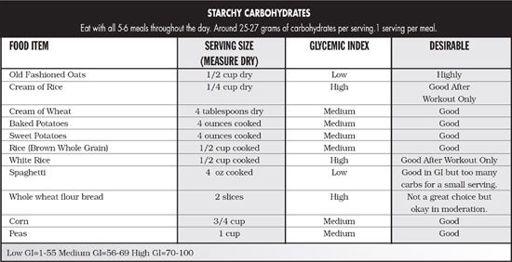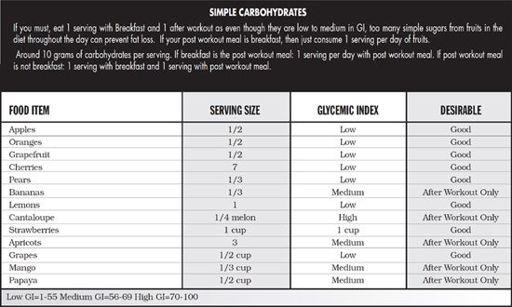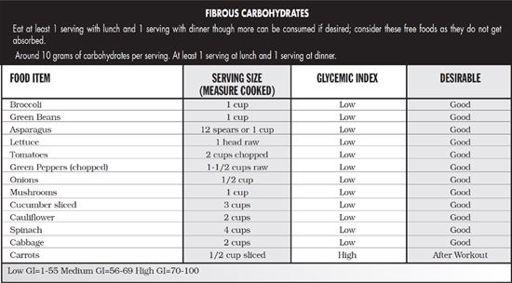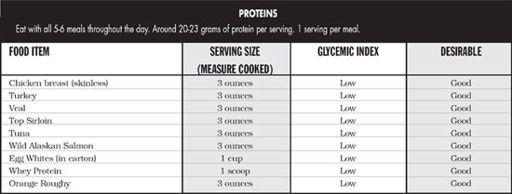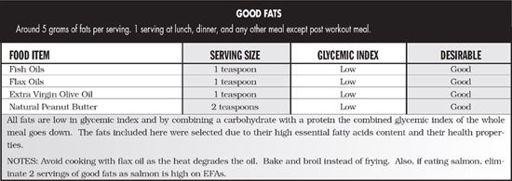The Body Sculpting Bible for Women (17 page)
Read The Body Sculpting Bible for Women Online
Authors: James Villepigue,Hugo Rivera
Tags: #Health & Fitness, #Exercise, #General, #Women's Health

Coconut oil, palm oil, and palm kernel oil, which are also frequently used in packaged foods, and non-dairy creamers are highly saturated. These oils are also many times hydrogenated. If you read the ingredient label of an item and see that it says “partially hydrogenated (name of oil)”, then immediately put that item back on the shelf. Consider partially hydrogenated oils poison to your body.
Polyunsaturated Fats
make up most of the fats in vegetable oils, such as corn, cottonseed, safflower, soybean, and sunflower oil. Also, flaxseed oil and fish oils are polyunsaturated. These last two fats are usually high in the Omega 3 Essential Fatty Acids (EFAs). What are Omega 3 EFA’s? Omega 3 EFAs are one of the two essential fats that the body needs. “Essential” means that the body cannot produce it on its own and therefore must be obtained from diet. The other kind of EFAs the body needs are the Omega-6 oils. Flax and fish oils are high on the Omega 3, which help improve immune system, energy production, insulin, sensitivity, and hormonal production. In addition, they have been shown to have antilipogenic properties (help prevent fat storage) as well as help to burn body fat, and assist in improving recovery by having anti-inflammatory properties and by protecting muscle from being broken down. Omega-6 oils are also beneficial to the body by reducing post training inflammation. These oils, however, are more easily found in most vegetable oils, margarine, poultry and eggs so we don’t see a need to supplement them further.
Monounsaturated Fats
make a positive effect on the good cholesterol levels. Sources of these fats are virgin olive oil, canola oil, and peanut oil. 20 % of your calories should come from good fats. Any less than 20% and your hormonal production goes down. Any more than 20% and you start accumulating plenty of fat.
Good sources of fat are non-processed vegetable oils such as canola oil, safflower oil, natural peanut butter, olive oil, flaxseed oil, and fish oils.
WATER
Water is by far the most abundant substance in our body. Without water, an organism would not survive very long. Most people who come to us for advice on how to get in shape, almost always underestimate the great value of water.
Water is good for the following reasons:
• Over 65% of your body is composed of water (most of your muscle cells are composed of water).
• Water cleanses your body of toxins and pollutants that can make you sick.
• Water is needed for all of the complex chemical reactions that your body performs on a daily basis. Processes such as energy production, muscle building, and fat burning all require water. A lack of water would interrupt all of these processes.
• Water helps lubricate the joints for increased mobility and decreased joint pain.
• When the outside temperature increases, water serves as a coolant to lower body temperature to where it is supposed to be.
• Water helps control your appetite. Have you ever felt like you were still hungry after eating a huge meal? This might very well be an indication that your body is beginning to dehydrate.
You will notice that by drinking water at that time, your cravings will miraculously stop.
• Cold water increases your metabolism and aids in the breakdown of body fat.
In order to determine how much water your body needs each day, multiply your lean body weight by 0.66. This indicates how many ounces of water your body needs in a day for optimum function.
CHARACTERISTICS OF A GOOD NUTRITION PROGRAM
Now that we have discussed the main nutrients that your body needs day in and day out to function, let’s discuss what makes up a good nutrition program.
Your nutrition plan should be based on eating small and frequent meals throughout the day
. Why? Because when you feed your body several times a day, your metabolism greatly increases. In addition, whenever three hours go by without any food consumption, your body switches to a catabolic state (a state in which your body starts burning muscle for energy!). The body actually believes that it is starving and in an attempt to protect itself from starvation, begins to feed itself by cannibalizing on your lean muscle tissue! It also lowers its metabolic rate (rate at which the body burns calories) and begins to store ingested calories as fat for future use. Bad scenario to be catabolic! The diet industry has made us think that the key to losing fat requires an extreme restriction of calories. You can see how much this theory has worked as America continues to gain weight!
Nutrition Chart and Glycemic Index
The complete list of the glycemic index and glycemic load for 750 foods can be found in the article “International tables of glycemic index and glycemic load values: 2002,” by Kaye Foster-Powell, Susanna H.A. Holt, and Janette C. Brand-Miller in the July 2002 American Journal of Clinical Nutrition, Vol. 62, pages 5–56. <
http://www.ajcn.org/cgi/content/full/76/1/5
>
Another reason to eat frequent meals is to manage blood sugar, insulin management, and energy levels. Larger infrequent feedings result in larger releases of insulin, with blood sugar crashes resulting in low energy levels 30 minutes to an hour after the meal is eaten. In addition, whatever calories the body cannot use at that time are stored for future use as body fat. Also, when you fall into the state of low blood sugar, you get lethargic and may start to crave sweets. Smaller, more frequent feedings spike the metabolism and maintain a more stable blood sugar pattern that results in better utilization of nutrients, more stable energy, and reduced cravings (or even no cravings) throughout the day.
During the 14-Day Body Sculpting Program, you will be eating four to five meals a day or five to six if you are following The Advanced 14- Day Body Sculpting Program) at two and a half to three-hour intervals.
Your meals should contain carbohydrates, protein and fats in the correct ratios
. When you eat a meal that does not make up the proper balance of nutrients (for example an all carbohydrate meal; such as a pasta meal), you
will not yield the desired results. Every macronutrient has to be present for the body to absorb them and use them properly and efficiently. Without boring you with the effect of food on the body’s biochemistry, let’s just say that if you solely eat carbohydrates as a meal, your energy levels will crash in about 30 minutes, and your body will store any carbs that were not used as body fat. Conversely, if you only eat protein all the time, you will lack the energy. Therefore, by eating a meal with one serving of starchy carbohydrates, a serving of fibrous carbohydrates and a serving of protein, you will have most of the macronutrients that your body needs. Once you add a tablespoon of either extra virgin olive oil or flaxseed oil to one of your vegetable servings of the day, then you have covered all of your macronutrient requirements.
No smoking and limited alcohol consumption
. Both offer health problems which are not in line with what you are trying to accomplish. Alcohol in particular adds seven empty calories per gram to your diet, which is not a good situation when you are trying to control your caloric intake.
Increase your intake of protein
. Proteins are the building blocks of all living organisms. If you are trying to build a structure such as the Empire State Building any construction contractor will tell you that they will need way more raw material to build such a large structure than to build a regular house. The same thing happens with body sculpting. Several researchers have discovered that the protein needs of people engaged in weight training activities exceed those of sedentary people. While most researchers are still debating on the amount, most of us in the field agree that 1-1.5 grams of protein per pound of lean body mass is just about right for any hard training. “Now what about kidney damage?” some may ask. Well, according to research conducted in the year 2000 called, “Do Regular High Protein Diets Have Potential Health Risks on Kidney Function in Athletes?” published in the International Journal of Sports Nutrition (Jacques R. Poortmans and Oliver Dellalieux.
International Journal of Sports Nutrition
, 2000, 10), higher protein intakes do not pose a threat to healthy kidney function. Having said that, the same is not true if you already suffer from a kidney condition.
Reduce your intake of bad fats and bring on the good fats
. Bad fats are things like butter, cooking oils, and saturated fats such as the ones found in meats. However, ensure adequate intake of good fats such as flaxseed oil, extra virgin olive oil and natural peanut butter. One tablespoon of flaxseed oil a day covers all of the essential fatty acid requirements of most people.
Reduce your intake of sugars
. Foods laden with sugar cause a sharp rise in insulin levels. Insulin is a good hormone when it is not present in excess as it carries the amino acids from the protein into the muscle cells so that they can be used for growth and repair. It also carries carbohydrates into the liver and muscle cells for storage as glycogen (stored carbohydrates) that can be used for future occasions. However, in excess, once the body’s reserves of carbohydrate storage are full, insulin turns these carbs into fat!
